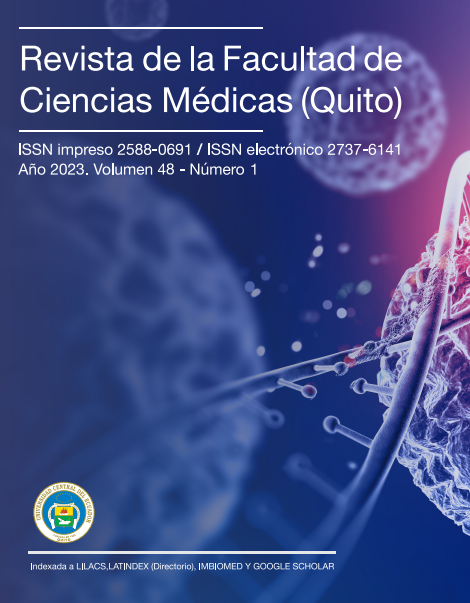Condiloma ano-perineal en una niña de 2 años, 8 meses y tratamiento con podofilina en combinación con ácido glicirricínico y ácido tricloroacético. Reporte de caso.
DOI:
https://doi.org/10.29166/rfcmq.v48i1.4376Palabras clave:
papiloma, podofilina, ácido glicirricínicoResumen
Introducción: Los condilomas o verrugas anogenitales son secundarios a una infección causada por el virus del papiloma humano en sitios específicos, como la piel de la región anogenital, en las mucosas vaginal y anal. Es una infección de transmisión sexual rara en la edad pediátrica, muy frecuente entre los adultos y adolescentes sexualmente activos; la causa en los infantes, sin descartar el abuso sexual podría ser: 1. En el momento del parto, en la etapa neonatal y durante los primeros años; 2. Autoinoculación o hetero-inoculación de los genitales de otros niños, de adultos, familiares como la madre o cuidadores. Podría manifestarse como pequeños papilomas o crecimientos verrugosos en la piel anogenital, en la mucosa de la vagina o el ano. Este caso tiene importancia clínica ya que los tratamientos convencionales presentan recidivas a corto plazo y muchos de ellos no son bien tolerados por los pequeños pacientes. Hay tratamientos agresivos como la criocirugía; el uso de medicamentos costosos como el Imiquimod; sin embargo, las recidivas son muy frecuentes con estos tratamientos convencionales.
Objetivo: Describir el uso de un esquema de terapia de tratamiento con podofilina en combinación con ácido glicirricínico y ácido tricloroacético, en una paciente pediátrica con diagnóstico de condiloma ano-perineal, para ayudar a disminuir las recidivas, los costos y sobre todo los efectos psicológicos que provocan los métodos dolorosos en los pequeños pacientes.
Presentación del caso: Paciente que presentó lesiones verrucosas, puntiagudos en la región ano-perineal; y, luego de haber sido intervenida en un centro de salud por varios días mediante la topicación sobre las lesiones una solución de ácido tricloro acético a 5% combinada con podofilina al 50%; sin embargo, el cuadro se exacerbó extendiéndose las lesiones hasta cerca del área genital. Luego de lo cual acudió a nuestra consulta, donde además de la combinación anterior, más la adición de ácido glicirricinico tópico y logrando a los 30 días la remisión de las lesiones.
Conclusiones y recomendaciones: La combinación de una sustancia corrosiva, el ácido tricloro acético, con una sustancia que detiene la multiplicación celular como la podofilina; y el ácido glicirricinico el cual disminuye la replicación de los virus en un estadio temprano, impide la salida del virión de su cápside y con esto su penetración a las células. La aplicación de esta triple terapia mejoró los resultados para condilomatosis en pacientes pediátricos.
Descargas
Métricas
Citas
Bussen S, Sütterlin M, Schmidt U, Bussen D. Anogenital Warts in Childhood - Always a Marker for Sexual Abuse? Geburtshilfe Frauenheilkd. 2012 Jan;72(1):43-48. doi: 10.1055/s-0031-1280417. PMID: 25253903; PMCID: PMC4168266.
Martín PY, Jiménez Alés R, Suárez RA, Berghezan SA, Morillo GB, Senosiaín M. Niño Con Infecciones Recurrentes. Asociación Española de Pediatría de Atención Primaria Al cuidado de la infancia y la adolescencia [Internet]. noviembre de 2016;1–27. Available from: https://www.aepap.org/grupos/grupo-depatologia-infecciosa/contenido/documentos-del-gpi
Tavassol P, Ahmed N, Kayani W, Jamshidi S, Bapat S, Imamovic A. Transmission of Human Papillomavirus Without Sexual Contact. Revue interdisciplinaire des sciences de la santé - Interdisciplinary Journal of Health Sciences. noviembre de 2016;8–12.
Sabeena S. Possible non-sexual modes of transmission of human papilloma virus. J. Obstet. Gynaecol. 2017. 429–435
Le TV, Fontenot C, Usta M, Hellstrom WJG, At G. Male Genital Dermatology: A Primer for the Sexual Medicine Physician. Sexual Medicine Review. enero de 2019;71–83
Myhre AK, Dalen A, Berntzen K, Bratlid D. Anogenital human papillomavirus in non-abused preschool children. Acta Paediatr [Internet]. diciembre de 2003; http Available from: s://pubmed.ncbi.nlm.nih.gov/14971797/
O’Mahony C. Position statement for the diagnosis and management of anogenital warts. Journal of the European Academy of Dermatology and Venereology. 2019. 1006–1019.
Stamm AW, Kobashi KC, Stefanovic KB. Urologic Dermatology: a Review. Current Urology Reports. junio de 2019;62.
Abu-Alhaija H, Zayed E, Abu-Alhaija B. Anogenital Papular Lesions in Children Five Year Old and Younger: Gender Differences. Med Arch. febrero de 2020;28–33.
Lee TS, Kothari-Talwar S, Singhal PK, Yee K, Kulkarni A, Lara N, et al. Cross-sectional study estimating the psychosocial impact of genital warts and other anogenital diseases in South Korea. BMJ Open. diciembre de 2018;1–12.
Sun ZG, Zhao TT, Lu N, Yang YA, Zhu HL. Research Progress of Glycyrrhizic Acid on Antiviral Activity. Mini Rev Med Chem. 2019;826–32
Bailly C, Vergoten G. Glycyrrhizin: An alternative drug for the treatment of COVID-19 infection and the associated respiratory syndrome? Pharmacology & Therapeutics. octubre de 2020;2–11.
Wang H, Ge X, Qu H, Wang N, Zhou J, Xu W, et al. Glycyrrhizic Acid Inhibits Proliferation of Gastric Cancer Cells by Inducing Cell Cycle Arrest and Apoptosis. Cancer Manag Res. abril de 2020;2853–61.
Leung AKC, Barankin B, Leong KF, Hon KL. Penile warts: an update on their evaluation and management. Drugs Context. diciembre de 2018;1–14.
Roberts JR, Siekas LL, Kaz AM. Anal intraepithelial neoplasia: A review of diagnosis and management. World J Gastrointest Oncol. febrero de 2017;50–61.
Lorduy MC, Ricardo JH, Arenas YH, Carmona WM. Use of trichloroacetic acid for management of oral lesions caused by human papillomavirus. Gen Dent. marzo de 2018;47–9.
Brogden DRL, Walsh U, Pellino G, Kontovounisios C, Tekkis P, Mills SC. Evaluating the efficacy of treatment options for anal intraepithelial neoplasia: a systematic review. Revue interdisciplinaire des sciences de la santé - Interdisciplinary Journal of Health Sciences. septiembre de 2020;213–26.
Concha N. Instructor Asociado Ginecología Infantil Módulo Docente UC Servicio de Pediatría, Hospital Sótero del Río. Julio de 2010.
Nieto-Jiménez A. Tratamiento del condiloma acuminado con criocirugía en edad pediátrica. Folia Dermatológica Cubana [Internet]. 2022 [citado Ener 2023]; 15 (2) Available from: https://revfdc.sld.cu/index.php/fdc/article/view/265
Descargas
Publicado
Cómo citar
Número
Sección
Licencia
Derechos de autor 2023 Efraín Aguagüiña, Diana Aguagüiña, william guaman gualpa, Javier Sebastián Vallejo Espinoza

Esta obra está bajo una licencia internacional Creative Commons Atribución-NoComercial-SinDerivadas 4.0.











